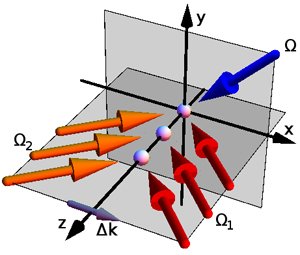Highlights
Dance like a neutrino: new quantum scheme to simulate particle oscillations

| |
The dance of neutrino particles oscillating between three flavours can be recreated in the quantum states of three trapped ions, CQT researchers have calculated. Lasers acting on the ions will create interactions mimicking those in neutrinos.
The behaviour of some of the most elusive particles in the known universe can be simulated using three atoms in a lab, CQT researchers have found.
Principal Investigator Dimitris G. Angelakis and his group members Changsuk Noh and Blas Rodriquez-Lara have devised a scheme that uses the quantum states of three charged ions to simulate the 'oscillations' of neutrinos. The proposal was published 16 March in New Journal of Physics; the paper was selected by the journal for its Highlights of 2012 collection.
The theorists hope to collaborate with experimentalists to realise this 'quantum simulation'. The long-standing idea of using a controllable, tunable quantum system in the lab to simulate the complicated behaviour of another quantum system is increasingly being put into practice – for example, in 2010 a very fast jittering predicted to occur for relativistic particles known as Zitterbewegung that had never been seen was simulated in a trapped ion by researchers in Austria.
Neutrinos are pesky things to study: they barely interact with matter and have a very tiny mass. Experiments to study them typically use vast detectors to capture neutrinos produced in the Sun or in particle accelerators. Physicists would like more precise measurements than such experiments have so far yielded since neutrino behaviour could provide a first glimpse of physics beyond the current Standard Model.
The new technique simulates the phenomenon known as neutrino oscillation: neutrinos flipping between their three types — electron, muon and tau — as they propagate. (No, the simulation won't help determine whether neutrinos travel faster than light, unfortunately.)
In the scheme, the three neutrino types are encoded in the quantum states of three ions, each having two energy levels. The ions are contained in an optical trap. Additional lasers (see figure above) set the ions vibrating — the vibrations, or phonons, contribute to making the trapped ions behave mathematically like fast-flying particles — and manipulate the ions' energy states.
The experimental techniques required to simulate neutrinos travelling in one space and one time dimension have already been demonstrated, say Changsuk, Blas and Dimitris. Changsuk and Blas are Research Fellows at CQT. Dimitris is a CQT Principal Investigator and a lecturer at the Science Department, Technical University of Crete, Greece.
Here, parameters describing the neutrino mass and interaction strength are inputs that determine the laser settings. This means that the model only reproduces effects already observed in experiments rather than allows new measurements.
A general hope for quantum simulations is that they will address problems too complex to study in situ and too hard to model on conventional computers. Neutrino oscillations in standard theory are easily calculated, however, the CQT researchers say the simulator could prove useful in exploring more exotic models of neutrino behaviour. The new scheme could also inspire simulations of other types of particles that come in three families such as quarks, the nucleons that form protons and neutrons, says the paper's first author, Changsuk.
For further details, see "Quantum simulation of neutrino oscillations with trapped ions", New J. Phys. 14, 033028 (2012); arXiv:1108.0182
Versions of this story were carried by news websites ScienceDaily, PhysOrg, SpaceDaily and ScienceNewsline.






